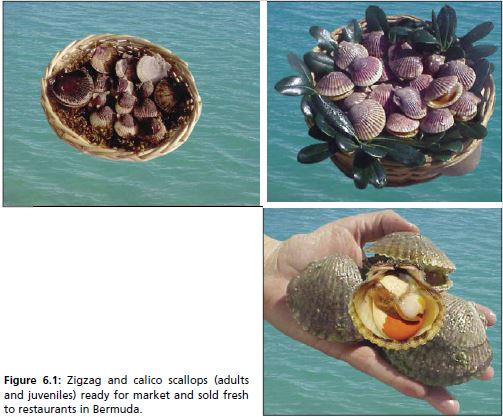6.3 FINAL PRODUCT
This manual has strived to provide step-by-step guidelines for the production of scallop. Scallops are considered a seafood delicacy and the fresh product is, in general, very much appreciated by chefs.
Several marketing studies have been conducted in Bermuda demonstrating the high demand for such fresh seafood on this island. Due to the difficulty in developing a cost-efficient growout methodology for sand scallops, large scale rearing is not commercially feasible for this species at this time. However, methods described for the calico scallop have proved successful on a commercial scale. Calico scallops are generally sold at 1.5–2 years old; the whole animal is used and often served in its shell. Scallops, with ripe gonads, are usually preferred by the restaurant trade. A second marketing scheme, selling 30 mm scallops to Italian restaurants, also became successful as young scallops are cooked whole in the shell and mixed in with pasta dishes. The colourful shell of calico scallops and the low price of younger individuals are found to attract this market (Figure 6.1).

Figure 6.1: Zigzag and calico scallops (adults and juveniles) ready for market and sold fresh to restaurants in Bermuda.
The rapid growth rate of these tropical species makes them a good candidate for culture, minimizing risks and costs associated with a long growout period.
This work provides an additional technology for the culture of tropical and sub tropical scallop species. The techniques have been well tested over the past four years and scaling-up production for commercial purposes can be easily done following the Bermuda protocol by simply increasing the tank capacity (the number of tanks or tank volume) for larval and post-larval rearing. This technology can be adapted to other tropical and sub-tropical regions and to other species. Furthermore, the concept of the module hatchery housed in mobile containers provides a relatively inexpensive facility for the rearing of bivalves, minimizing initial capital costs for the set-up of a commercial operation. Due to the flexible nature of the facility, species-specific requirements can easily be accommodated with the current design. Finally, this type of modular or “portable” hatchery can be advantageous for those areas limited in space (like Bermuda), and/or in areas which are potentially prone to pollution issues. The only requirement for such a hatchery is access to clean seawater.